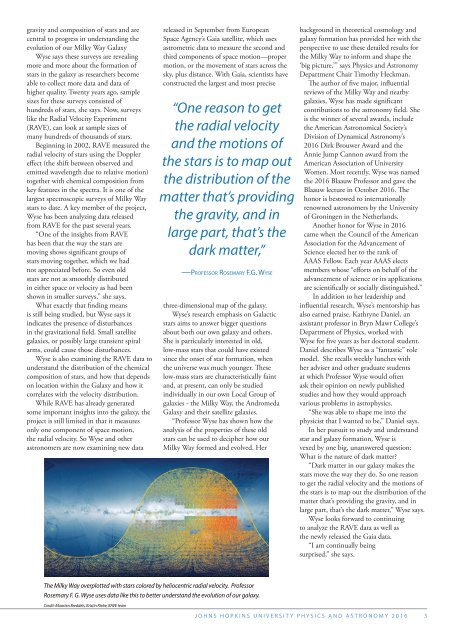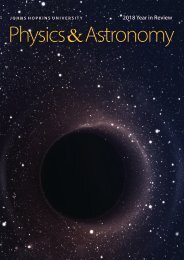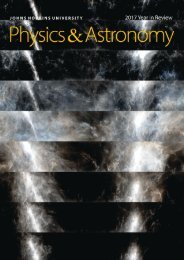2016_PA_Newsletter_12_29_16_FINAL
You also want an ePaper? Increase the reach of your titles
YUMPU automatically turns print PDFs into web optimized ePapers that Google loves.
gravity and composition of stars and are<br />
central to progress in understanding the<br />
evolution of our Milky Way Galaxy<br />
Wyse says these surveys are revealing<br />
more and more about the formation of<br />
stars in the galaxy as researchers become<br />
able to collect more data and data of<br />
higher quality. Twenty years ago, sample<br />
sizes for these surveys consisted of<br />
hundreds of stars, she says. Now, surveys<br />
like the Radial Velocity Experiment<br />
(RAVE), can look at sample sizes of<br />
many hundreds of thousands of stars.<br />
Beginning in 2002, RAVE measured the<br />
radial velocity of stars using the Doppler<br />
effect (the shift between observed and<br />
emitted wavelength due to relative motion)<br />
together with chemical composition from<br />
key features in the spectra. It is one of the<br />
largest spectroscopic surveys of Milky Way<br />
stars to date. A key member of the project,<br />
Wyse has been analyzing data released<br />
from RAVE for the past several years.<br />
“One of the insights from RAVE<br />
has been that the way the stars are<br />
moving shows significant groups of<br />
stars moving together, which we had<br />
not appreciated before. So even old<br />
stars are not as smoothly distributed<br />
in either space or velocity as had been<br />
shown in smaller surveys,” she says.<br />
What exactly that finding means<br />
is still being studied, but Wyse says it<br />
indicates the presence of disturbances<br />
in the gravitational field. Small satellite<br />
galaxies, or possibly large transient spiral<br />
arms, could cause those disturbances.<br />
Wyse is also examining the RAVE data to<br />
understand the distribution of the chemical<br />
composition of stars, and how that depends<br />
on location within the Galaxy and how it<br />
correlates with the velocity distribution.<br />
While RAVE has already generated<br />
some important insights into the galaxy, the<br />
project is still limited in that it measures<br />
only one component of space motion,<br />
the radial velocity. So Wyse and other<br />
astronomers are now examining new data<br />
released in September from European<br />
Space Agency’s Gaia satellite, which uses<br />
astrometric data to measure the second and<br />
third components of space motion—proper<br />
motion, or the movement of stars across the<br />
sky, plus distance. With Gaia, scientists have<br />
constructed the largest and most precise<br />
“One reason to get<br />
the radial velocity<br />
and the motions of<br />
the stars is to map out<br />
the distribution of the<br />
matter that’s providing<br />
the gravity, and in<br />
large part, that’s the<br />
dark matter,”<br />
—Professor Rosemary F.G. Wyse<br />
three-dimensional map of the galaxy.<br />
Wyse’s research emphasis on Galactic<br />
stars aims to answer bigger questions<br />
about both our own galaxy and others.<br />
She is particularly interested in old,<br />
low-mass stars that could have existed<br />
since the onset of star formation, when<br />
the universe was much younger. These<br />
low-mass stars are characteristically faint<br />
and, at present, can only be studied<br />
individually in our own Local Group of<br />
galaxies - the Milky Way, the Andromeda<br />
Galaxy and their satellite galaxies.<br />
“Professor Wyse has shown how the<br />
analysis of the properties of these old<br />
stars can be used to decipher how our<br />
Milky Way formed and evolved. Her<br />
background in theoretical cosmology and<br />
galaxy formation has provided her with the<br />
perspective to use these detailed results for<br />
the Milky Way to inform and shape the<br />
‘big picture,’” says Physics and Astronomy<br />
Department Chair Timothy Heckman.<br />
The author of five major, influential<br />
reviews of the Milky Way and nearby<br />
galaxies, Wyse has made significant<br />
contributions to the astronomy field. She<br />
is the winner of several awards, include<br />
the American Astronomical Society’s<br />
Division of Dynamical Astronomy’s<br />
<strong>20<strong>16</strong></strong> Dirk Brouwer Award and the<br />
Annie Jump Cannon award from the<br />
American Association of University<br />
Women. Most recently, Wyse was named<br />
the <strong>20<strong>16</strong></strong> Blaauw Professor and gave the<br />
Blaauw lecture in October <strong>20<strong>16</strong></strong>. The<br />
honor is bestowed to internationally<br />
renowned astronomers by the University<br />
of Groningen in the Netherlands.<br />
Another honor for Wyse in <strong>20<strong>16</strong></strong><br />
came when the Council of the American<br />
Association for the Advancement of<br />
Science elected her to the rank of<br />
AAAS Fellow. Each year AAAS elects<br />
members whose “efforts on behalf of the<br />
advancement of science or its applications<br />
are scientifically or socially distinguished.”<br />
In addition to her leadership and<br />
influential research, Wyse’s mentorship has<br />
also earned praise. Kathryne Daniel, an<br />
assistant professor in Bryn Mawr College’s<br />
Department of Physics, worked with<br />
Wyse for five years as her doctoral student.<br />
Daniel describes Wyse as a “fantastic” role<br />
model. She recalls weekly lunches with<br />
her adviser and other graduate students<br />
at which Professor Wyse would often<br />
ask their opinion on newly published<br />
studies and how they would approach<br />
various problems in astrophysics.<br />
“She was able to shape me into the<br />
physicist that I wanted to be,” Daniel says.<br />
In her pursuit to study and understand<br />
star and galaxy formation, Wyse is<br />
vexed by one big, unanswered question:<br />
What is the nature of dark matter?<br />
“Dark matter in our galaxy makes the<br />
stars move the way they do. So one reason<br />
to get the radial velocity and the motions of<br />
the stars is to map out the distribution of the<br />
matter that’s providing the gravity, and in<br />
large part, that’s the dark matter,” Wyse says.<br />
Wyse looks forward to continuing<br />
to analyze the RAVE data as well as<br />
the newly released the Gaia data.<br />
“I am continually being<br />
surprised,” she says.<br />
The Milky Way overplotted with stars colored by heliocentric radial velocity. Professor<br />
Rosemary F. G. Wyse uses data like this to better understand the evolution of our galaxy.<br />
Credit: Maarten Breddels, Kristin Riebe, RAVE team<br />
JOHNS HOPKINS UNIVERSITY PHYSICS AND ASTRONOMY <strong>20<strong>16</strong></strong> 3










